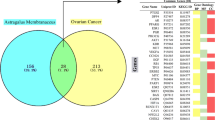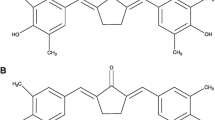Abstract
Naringenin is a natural bioactive flavonoid with a wide spectrum of biological activities, including anti-carcinogenic ability. Our study aimed to investigate the effect of naringenin on ovarian cancer (OC) progression. Naringenin was input into PharmMapper and SwissTargetPrediction databases to predict its targets, and OC-related targets were obtained using MalaCards and GEPIA databases, which were imported into online Venn tool to identify the common targets. B-cell lymphoma-2 like 1 (BCL2L1) expression in OC tissues and cells was detected using GEPIA and HPA databases, qRT-PCR and Western blot analysis. The prognostic and diagnostic values of BCL2L1 in OC were determined using Kaplan–Meier plotter tool and receiver operating characteristic (ROC) curve analysis, respectively. Cell proliferation was evaluated using CCK-8 and EdU incorporation assays. Cell apoptosis was determined using TUNEL and caspase-3 activity assays. Effect of naringenin on the phosphatidylinositol 3-kinase (PI3K)/protein kinase B (Akt) pathway was evaluated by Western blot analysis. BCL2L1 was identified as the candidate target of naringenin against OC. BCL2L1 was upregulated in OC tissues and cells. Naringenin decreased BCL2L1 expression and inactivated the PI3K/Akt pathway in OC cells. Naringenin inhibited cell proliferation and increased the apoptotic rate in OC cells, while these effects were partially abolished by BCL2L1 overexpression and treatment with 740Y-P, a PI3K activator. In conclusion, naringenin exerted an anti-tumor effect on OC progression via inactivation of the PI3K/Akt/BCL2L1 pathway.








Similar content being viewed by others
Data availability
The data that support the findings of this study are available from the corresponding author upon reasonable request.
References
La Vecchia C (2017) Ovarian cancer: epidemiology and risk factors. Eur J Cancer Prev 26(1):55–62
Siegel R, Ward E, Brawley O, Jemal A (2011) Cancer statistics, 2011: the impact of eliminating socioeconomic and racial disparities on premature cancer deaths. CA Cancer J Clin 61(4):212–236
Kossaï M, Leary A, Scoazec JY, Genestie C (2018) Ovarian cancer: a heterogeneous disease. Pathobiology 85(1–2):41–49
Gstöttner M, Angerer A, Rosiek R, Bach CM (2012) Quantitative volumetry of cement leakage in viscosity-controlled vertebroplasty. J Spinal Disord Tech 25(5):E150-154
Kim A, Ueda Y, Naka T, Enomoto T (2012) Therapeutic strategies in epithelial ovarian cancer. J Exp Clin Cancer Res 31(1):14
Zsiros E, Tanyi J, Balint K, Kandalaft LE (2014) Immunotherapy for ovarian cancer: recent advances and perspectives. Curr Opin Oncol 26(5):492–500
Sudo T (2012) Molecular-targeted therapies for ovarian cancer: prospects for the future. Int J Clin Oncol 17(5):424–429
Temkin SM, Terplan M (2015) Trends in relative survival for ovarian cancer from 1975–2011. Obstet Gynecol 126(4):898
Safarzadeh E, Sandoghchian Shotorbani S, Baradaran B (2014) Herbal medicine as inducers of apoptosis in cancer treatment. Adv Pharm Bull 4(Suppl 1):421–427
Panche AN, Diwan AD, Chandra SR (2016) Flavonoids: an overview. J Nutr Sci 5:e47
Kawaii S, Tomono Y, Katase E, Ogawa K, Yano M (1999) Quantitation of flavonoid constituents in citrus fruits. J Agric Food Chem 47(9):3565–3571
Meiyanto E, Hermawan A, Anindyajati A (2012) Natural products for cancer-targeted therapy: citrus flavonoids as potent chemopreventive agents. Asian Pac J Cancer Prev 13(2):427–436
Wang J, Yang Z, Lin L, Zhao Z, Liu Z, Liu X (2012) Protective effect of naringenin against lead-induced oxidative stress in rats. Biol Trace Elem Res 146(3):354–359
Bodet C, La VD, Epifano F, Grenier D (2008) Naringenin has anti-inflammatory properties in macrophage and ex vivo human whole-blood models. J Periodontal Res 43(4):400–407
Lee CH, Jeong TS, Choi YK, Hyun BH, Oh GT, Kim EH et al (2001) Anti-atherogenic effect of citrus flavonoids, naringin and naringenin, associated with hepatic ACAT and aortic VCAM-1 and MCP-1 in high cholesterol-fed rabbits. Biochem Biophys Res Commun 284(3):681–688
Kanno S, Shouji A, Hirata R, Asou K, Ishikawa M (2004) Effects of naringin on cytosine arabinoside (Ara-C)-induced cytotoxicity and apoptosis in P388 cells. Life Sci 75(3):353–365
Wang BD, Yang ZY, Wang Q, Cai TK, Crewdson P (2006) Synthesis, characterization, cytotoxic activities, and DNA-binding properties of the La(III) complex with naringenin Schiff-base. Bioorg Med Chem 14(6):1880–1888
Wang X, Shen Y, Wang S, Li S, Zhang W, Liu X et al (2017) PharmMapper 2017 update: a web server for potential drug target identification with a comprehensive target pharmacophore database. Nucleic Acids Res 45(W1):W356-w360
Gfeller D, Grosdidier A, Wirth M, Daina A, Michielin O, Zoete V (2014) SwissTargetPrediction: a web server for target prediction of bioactive small molecules. Nucleic Acids Res 42(Web Server issue):W32–W38
Rappaport N, Twik M, Plaschkes I, Nudel R, Iny Stein T, Levitt J et al (2017) MalaCards: an amalgamated human disease compendium with diverse clinical and genetic annotation and structured search. Nucleic Acids Res 45(D1):D877-d887
Tang Z, Li C, Kang B, Gao G, Li C, Zhang Z (2017) GEPIA: a web server for cancer and normal gene expression profiling and interactive analyses. Nucleic Acids Res 45(W1):W98-w102
Thul PJ, Lindskog C (2018) The human protein atlas: a spatial map of the human proteome. Protein Sci 27(1):233–244
Deng J, Wang L, Chen H, Hao J, Ni J, Chang L et al (2016) Targeting epithelial–mesenchymal transition and cancer stem cells for chemoresistant ovarian cancer. Oncotarget 7(34):55771–55788
Moyer VA (2012) Screening for ovarian cancer: U.S. Preventive Services Task Force reaffirmation recommendation statement. Ann Intern Med 157(12):900–904
Colombo N, Lorusso D, Scollo P (2017) Impact of recurrence of ovarian cancer on quality of life and outlook for the future. Int J Gynecol Cancer 27(6):1134–1140
Dutta S, Mahalanobish S, Saha S, Ghosh S, Sil PC (2019) Natural products: an upcoming therapeutic approach to cancer. Food Chem Toxicol 128:240–255
Ravishankar D, Rajora AK, Greco F, Osborn HM (2013) Flavonoids as prospective compounds for anti-cancer therapy. Int J Biochem Cell Biol 45(12):2821–2831
Joshi R, Kulkarni YA, Wairkar S (2018) Pharmacokinetic, pharmacodynamic and formulations aspects of naringenin: an update. Life Sci 215:43–56
Wang R, Wang J, Dong T, Shen J, Gao X, Zhou J (2019) Naringenin has a chemoprotective effect in MDA-MB-231 breast cancer cells via inhibition of caspase-3 and -9 activities. Oncol Lett 17(1):1217–1222
Sabarinathan D, Mahalakshmi P, Vanisree AJ (2010) Naringenin promote apoptosis in cerebrally implanted C6 glioma cells. Mol Cell Biochem 345(1–2):215–222
Lim W, Park S, Bazer FW, Song G (2017) Naringenin-induced apoptotic cell death in prostate cancer cells is mediated via the PI3K/AKT and MAPK signaling pathways. J Cell Biochem 118(5):1118–1131
Kanno S, Tomizawa A, Ohtake T, Koiwai K, Ujibe M, Ishikawa M (2006) Naringenin-induced apoptosis via activation of NF-kappaB and necrosis involving the loss of ATP in human promyeloleukemia HL-60 cells. Toxicol Lett 166(2):131–139
Chen YC, Shen SC, Lin HY (2003) Rutinoside at C7 attenuates the apoptosis-inducing activity of flavonoids. Biochem Pharmacol 66(7):1139–1150
Revil T, Toutant J, Shkreta L, Garneau D, Cloutier P, Chabot B (2007) Protein kinase C-dependent control of Bcl-x alternative splicing. Mol Cell Biol 27(24):8431–8441
Warren CFA, Wong-Brown MW, Bowden NA (2019) BCL-2 family isoforms in apoptosis and cancer. Cell Death Dis 10(3):177
Harmalkar M, Upraity S, Kazi S, Shirsat NV (2015) Tamoxifen-induced cell death of malignant glioma cells is brought about by oxidative-stress-mediated alterations in the expression of BCL2 family members and is enhanced on miR-21 inhibition. J Mol Neurosci 57(2):197–202
Porta C, Paglino C, Mosca A (2014) Targeting PI3K/Akt/mTOR signaling in cancer. Front Oncol 4:64
Alzahrani AS (2019) PI3K/Akt/mTOR inhibitors in cancer: at the bench and bedside. Semin Cancer Biol 59:125–132
Mabuchi S, Kuroda H, Takahashi R, Sasano T (2015) The PI3K/AKT/mTOR pathway as a therapeutic target in ovarian cancer. Gynecol Oncol 137(1):173–179
Dobbin ZC, Landen CN (2013) The importance of the PI3K/AKT/MTOR pathway in the progression of ovarian cancer. Int J Mol Sci 14(4):8213–8227
Cai J, Xu L, Tang H, Yang Q, Yi X, Fang Y et al (2014) The role of the PTEN/PI3K/Akt pathway on prognosis in epithelial ovarian cancer: a meta-analysis. Oncologist 19(5):528–535
Singh R, Letai A (2019) Regulation of apoptosis in health and disease: the balancing act of BCL-2 family proteins. CA Cancer J Clin 20(3):175–193
Khwaja A (1999) Akt is more than just a Bad kinase. Nature 401(6748):33–34
Ke X, Li L, Li J, Zheng M, Liu P (2021) Anti-oncogenic PTEN induces ovarian cancer cell senescence by targeting P21. Cell Biol Int. https://doi.org/10.1002/cbin.11709
Martins FC, Couturier DL, Paterson A, Karnezis AN, Chow C, Nazeran TM et al (2020) Clinical and pathological associations of PTEN expression in ovarian cancer: a multicentre study from the Ovarian Tumour Tissue Analysis Consortium. Br J Cancer 123(5):793–802
Zhu B, Wei Y (2020) Antitumor activity of celastrol by inhibition of proliferation, invasion, and migration in cholangiocarcinoma via PTEN/PI3K/Akt pathway. Cancer Med 9(2):783–796
De Marco C, Laudanna C, Rinaldo N, Oliveira DM, Ravo M, Weisz A et al (2017) Specific gene expression signatures induced by the multiple oncogenic alterations that occur within the PTEN/PI3K/AKT pathway in lung cancer. PLoS ONE 12(6):e0178865
Jia B, Yu D, Yu G, Cheng Y, Wang Y, Yi X et al (2018) Naringenin improve hepatitis C virus infection induced insulin resistance by increase PTEN expression via p53-dependent manner. Biomed Pharmacother 103:746–754
Muthumanickam S, Indhumathi T, Boomi P, Balajee R, Jeyakanthan J, Anand K et al (2020) In silico approach of naringin as potent phosphatase and tensin homolog (PTEN) protein agonist against prostate cancer. J Biomol Struct Dyn. https://doi.org/10.1080/07391102.2020.1830855
Acknowledgements
None.
Funding
The authors have not disclosed any funding.
Author information
Authors and Affiliations
Contributions
JX conducted the experiments and wrote the manuscript. ZG conducted the experiments. SY and HL collected and analyzed the data.
Corresponding author
Ethics declarations
Conflict of interest
No conflict of interest.
Ethical approval
Not applicable.
Consent for publication
Not applicable.
Consent to participate
Not applicable.
Additional information
Publisher's Note
Springer Nature remains neutral with regard to jurisdictional claims in published maps and institutional affiliations.
Supplementary Information
Below is the link to the electronic supplementary material.
Rights and permissions
About this article
Cite this article
Xu, J., Guo, Z., Yuan, S. et al. BCL2L1 is identified as a target of naringenin in regulating ovarian cancer progression. Mol Cell Biochem 477, 1541–1553 (2022). https://doi.org/10.1007/s11010-022-04389-1
Received:
Accepted:
Published:
Issue Date:
DOI: https://doi.org/10.1007/s11010-022-04389-1




